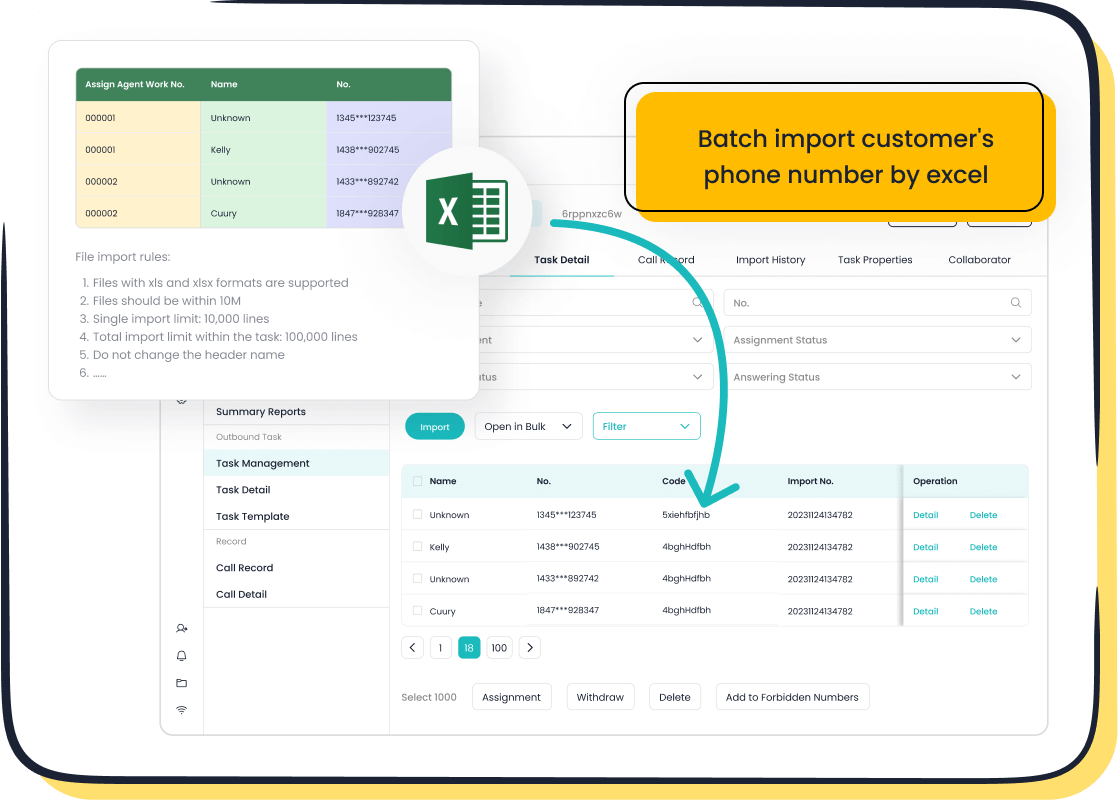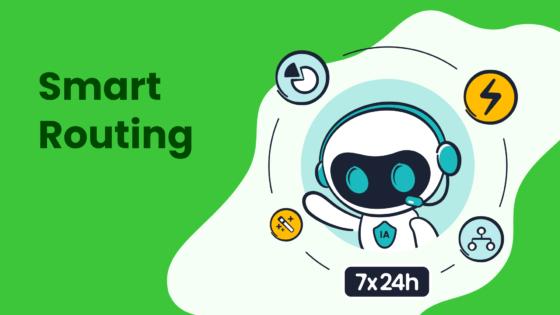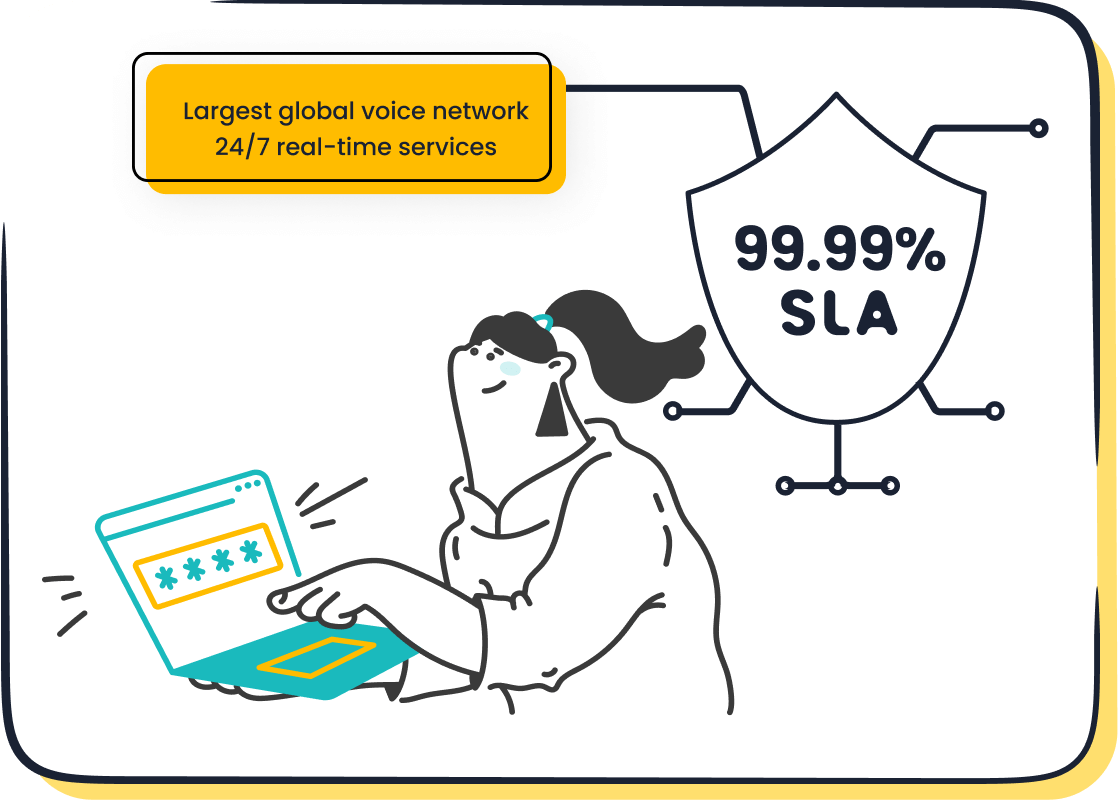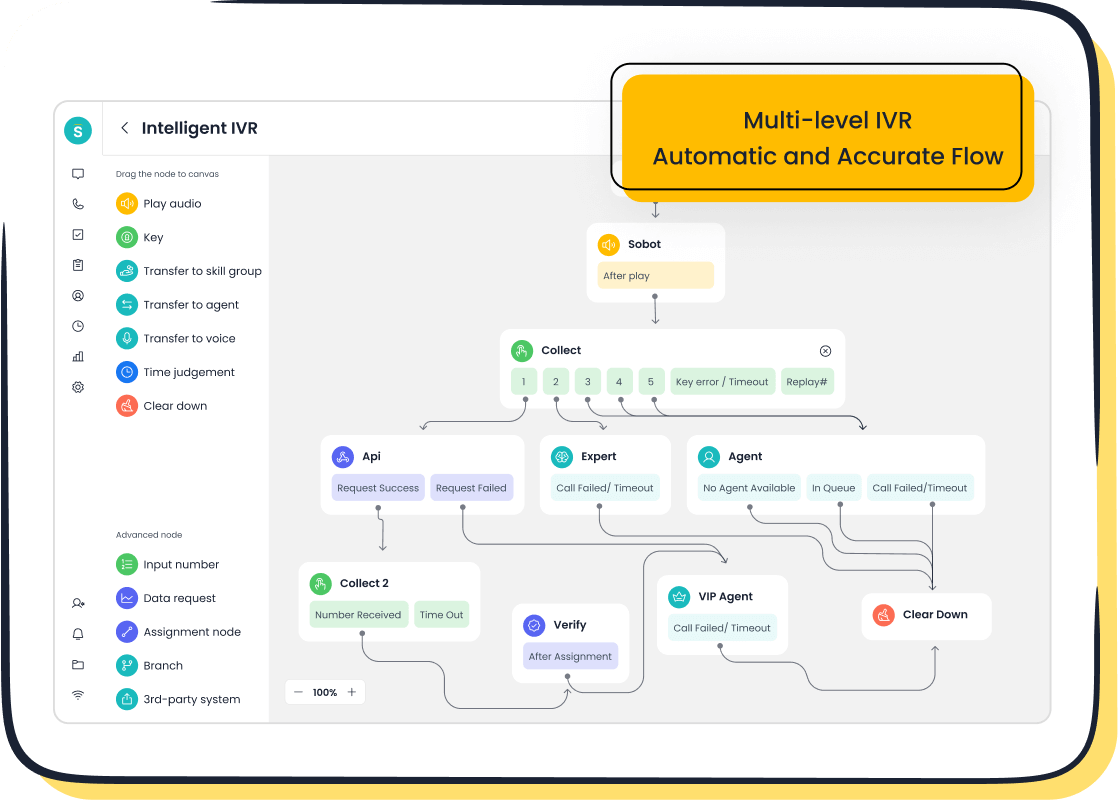What is Automatic Number Identification (ANI)

Automatic number identification (ANI) is a telecommunication feature that identifies and transmits the phone number of the caller. It has transformed how businesses handle customer interactions by streamlining communication processes. In call centers, ANI allows agents to access customer details before answering calls. This reduces the time spent gathering basic information and ensures a smoother experience. Calls can also be routed based on the caller’s location or past interactions, enabling personalized service. Automated systems use ANI to verify identities, detect fraud, and prioritize calls, which improves efficiency. Solutions like Sobot’s Voice/Call Center leverage ANI to enhance workflows and deliver exceptional customer support.
How Does Automatic Number Identification (ANI) Work?
The Technical Process of ANI
Capturing and Transmitting Caller Information

ANI captures the caller's phone number and transmits it through a telecommunication signaling system. When a call is initiated, the exchange collects the caller's number, including details like the dialing code and location based on the area code. This information is sent to the recipient's network during the call connection process. Even if the caller ID is blocked, ANI ensures the number is available for identification. Once received, the data integrates seamlessly with systems like CRM or call management platforms. This allows agents to access customer profiles and transaction histories instantly, improving efficiency and personalization.
Integration with Telecommunication Networks
The integration of ANI with telecommunication networks relies on advanced signaling systems like Signaling System No. 7 (SS7). This system ensures the accurate transmission of caller information across networks. Businesses often enhance this process by upgrading their infrastructure and deploying digital certificates to verify call data. Continuous monitoring tools, such as WebRTC Internals, track performance and maintain call quality. These technical components ensure ANI functions effectively, providing reliable caller identification services.
| Component | Description |
|---|---|
| Digital Certificates | Used to sign and verify call data, ensuring its authenticity. |
| Infrastructure Upgrades | Necessary to support new protocols, involving software and hardware updates. |
| Initial Deployment Costs | Costs associated with acquiring digital certificates and upgrading infrastructure. |
| Ongoing Maintenance | Regular updates and monitoring required to maintain system effectiveness. |
| Adaptive Bitrate Streaming | Adjusts video quality based on network conditions for optimal call quality. |
| Continuous Monitoring | Tools like WebRTC Internals track performance and provide insights into call quality. |
| Training and Awareness | Ensuring technical staff are trained in protocols and users are informed about their benefits. |
ANI vs. Caller ID
Key Differences in Accuracy and Functionality
ANI and caller ID serve similar purposes but differ in accuracy and functionality. ANI provides reliable data directly through the signaling system, making it more accurate than caller ID. Caller ID, on the other hand, can be manipulated or blocked by the caller, reducing its reliability. ANI also prevents spam callers from falsifying or hiding their numbers, ensuring accurate identification. These differences make ANI a preferred choice for businesses that require dependable caller identification services.
Use Cases in Customer Service and Business
ANI outperforms caller ID in several customer service scenarios. It allows contact centers to recognize customers immediately, enabling agents to greet them by name and access relevant account histories. This enhances the customer experience. ANI also integrates with CRM systems to match a caller's number with existing records, streamlining call routing and reducing repetitive questions. Its reliability ensures accurate identification, making it ideal for businesses focused on efficiency and security.
The Purpose of Automatic Number Identification (ANI)
Enhancing Call Routing and Efficiency
Directing Calls to the Right Agent or Department
ANI simplifies call routing by automatically directing calls to the most suitable agent or department. When a customer contacts your business, ANI identifies their phone number and retrieves relevant details, such as their location or past interactions. This information ensures that calls are routed to the right agent who can address the customer’s needs effectively. For example:
- ANI uses the caller’s area code to connect them with a local representative.
- It distributes calls among agents based on availability and expertise.
- It retrieves customer data to enable personalized interactions.

By leveraging ANI, businesses like those using Sobot’s Voice/Call Center can optimize call distribution. Features like smart call routing ensure that customers receive prompt assistance, improving overall satisfaction.
Reducing Wait Times for an Improved Customer Experience
Efficient call routing reduces wait times significantly. ANI enables your system to prioritize calls based on urgency or customer history. For instance, high-value customers can be routed to senior agents immediately. This streamlined process minimizes delays and enhances the experience for every customer. With tools like Sobot’s intelligent IVR and AI-powered Voicebot, businesses can further automate workflows, ensuring faster resolutions and an improved customer experience.
Supporting Billing and Reporting
Accurate Call Tracking for Billing Purposes
ANI plays a vital role in accurate billing by reliably identifying the caller’s number. This ensures that every call is tracked and billed correctly. The validation process prevents fraudulent activities, such as spoofed numbers, from affecting your records. Businesses can rely on ANI to maintain transparency in their billing systems. For example, Sobot’s Call Tracking feature integrates ANI data to provide detailed call logs, ensuring precise billing for both inbound and outbound calls.
Generating Analytics for Business Insights
ANI also supports reporting by generating valuable analytics. It collects accurate data on call patterns, durations, and customer interactions. This information helps you identify trends and improve service quality. For instance:
- ANI data reveals peak call times, enabling better workforce management.
- It highlights frequently contacted departments, helping you allocate resources effectively.
- It provides insights into customer behavior, aiding in strategic decision-making.

Sobot’s Voice/Call Center enhances this process with real-time monitoring and analysis tools. These features allow you to transform ANI data into actionable insights, driving better business outcomes.
Benefits of Automatic Number Identification (ANI) in Customer Service
Improved Customer Experience
Personalizing Customer Interactions
ANI enables personalized customer service by providing agents with instant access to caller information. Features like screen pop-ups and automatic account retrieval in CRM systems allow customer service agents to greet callers by name and address their needs without asking repetitive questions. This reduces call handling time and ensures accurate service delivery. For example, when a customer calls a business using Sobot’s Voice/Call Center, the system retrieves their account history and displays it for the agent. This fosters a sense of value and creates a positive impression of your business. Personalized service like this enhances customer satisfaction and builds loyalty.
Faster Issue Resolution with ANI Data
ANI data accelerates issue resolution by automating caller identification and routing. When a customer contacts your business, ANI immediately verifies their number and retrieves relevant details. This allows agents to focus on solving problems rather than verifying account information. For instance:
| Evidence Description | Impact on Issue Resolution |
|---|---|
| ANI enables contact centers to recognize customers immediately upon calling. | Agents can greet customers by name and access relevant histories quickly. |
| ANI automates the verification of caller information. | Agents can focus on resolving issues rather than verifying account details. |
| ANI routes calls based on caller’s location or previous interactions. | This creates a more personalized experience, leading to quicker resolutions. |
| ANI provides immediate access to customer details. | Agents can tailor interactions and make personalized recommendations, enhancing efficiency. |

With tools like Sobot’s intelligent IVR and AI-powered Voicebot, businesses can further streamline workflows, ensuring faster resolutions and improved customer satisfaction.
Enhanced Security and Fraud Prevention
Identifying Suspicious or Unwanted Calls
ANI strengthens security by identifying suspicious patterns in caller behavior. It detects numbers associated with scams or unusual activity, such as frequent hang-ups or calls from unexpected locations. This capability alerts customer service agents to potential threats, enabling them to take appropriate action. For industries like finance or healthcare, where protecting sensitive information is critical, ANI provides an additional layer of security by verifying caller numbers and flagging unrecognized ones.
Protecting Sensitive Customer Information
ANI plays a vital role in safeguarding sensitive customer data. By verifying the caller’s number, it reduces the risk of fraud or unauthorized access. This is particularly beneficial for businesses handling confidential information, such as financial institutions or healthcare providers. For example:
- ANI verifies the caller's number to identify suspicious or unrecognized numbers.
- It minimizes the risk of fraud by ensuring accurate caller identification.
- It protects sensitive data, ensuring compliance with industry regulations.

Sobot’s Voice/Call Center integrates ANI to provide secure communication solutions, helping businesses maintain trust and protect their customers.
Streamlined Business Operations
Automating Call Logging and Tracking
ANI automates call logging and tracking, saving time and improving operational efficiency. It records caller details, call durations, and interaction histories automatically. This eliminates the need for manual data entry, allowing agents to focus on delivering exceptional service. For example, Sobot’s Call Tracking feature uses ANI to generate detailed call logs, enabling businesses to analyze performance and optimize processes.
Supporting Workforce Management with ANI Insights
ANI provides valuable insights that support workforce management. By analyzing call patterns and customer behavior, businesses can allocate resources more effectively. For instance:
| Efficiency Type | Description |
|---|---|
| Faster Customer Identification | ANI allows agents to access customer data before answering, reducing time spent on basic info. |
| Improved Call Routing | Calls can be routed based on location or previous interactions, enhancing customer experience. |
| Personalized Customer Experience | Agents can greet customers by name and access histories, eliminating repetitive questions. |
High-volume call centers using ANI report a 20-30% improvement in service handling efficiency. Sobot’s Voice/Call Center enhances this process with real-time monitoring and analytics, helping businesses achieve operational excellence.
Practical Applications of ANI in Business and Call Centers
Integration with CRM Systems
Synchronizing Caller Data with Customer Profiles
Integrating ANI with CRM systems allows you to synchronize caller data with customer profiles automatically. When a call is received, ANI identifies the caller’s number and matches it with existing records in your CRM. This process eliminates the need for manual data entry, saving time and reducing errors. For example, if a customer contacts your business, the system retrieves their account history instantly, enabling agents to provide personalized service.
| Advantage | Description |
|---|---|
| Faster Customer Identification | ANI allows contact centers to recognize customers immediately, enabling personalized greetings and access to account histories. |
| Improved Call Routing | Calls can be directed to the appropriate department or agent based on caller information, enhancing efficiency. |
| Enhanced Fraud Prevention | ANI verifies caller numbers, helping to flag suspicious calls and reduce fraud risk, especially in sensitive industries. |
| Personalized Recommendations | Agents can tailor interactions and make recommendations based on the customer's history and preferences. |
Enabling Real-Time Customer Insights
ANI provides real-time insights by integrating with CRM systems. You can analyze customer behavior, preferences, and interaction history during the call. This data helps agents make informed decisions and offer tailored solutions. For instance, Sobot’s Voice/Call Center integrates ANI with CRM platforms, enabling agents to access customer profiles instantly. This feature enhances the overall customer experience by ensuring efficient and personalized interactions.
Use in Call Centers with Sobot Voice/Call Center
Optimizing Call Distribution with Smart Routing
ANI optimizes call distribution by routing calls to the most suitable agent or department. Sobot’s Voice/Call Center uses smart routing to analyze caller information and direct calls based on factors like location, language, or past interactions. This ensures that customers connect with the right agent quickly, reducing wait times and improving satisfaction. For example:
- High-priority calls can be routed to senior agents.
- Calls from specific regions can be directed to local representatives.
- Repeat callers can be connected to agents familiar with their history.
Monitoring Agent Performance and Call Analytics
ANI supports performance monitoring by providing detailed call analytics. Sobot’s Voice/Call Center tracks metrics like call duration, resolution time, and customer satisfaction. This data helps you evaluate agent performance and identify areas for improvement. For example, ANI data can reveal peak call times, enabling better resource allocation. By leveraging these insights, you can enhance efficiency and deliver a superior customer experience.
Applications in Emergency Services
Identifying Callers in Critical Situations
In emergency services, ANI plays a crucial role in identifying callers quickly. It provides accurate caller information, even if the number is blocked. This ensures that emergency responders can locate and assist individuals in critical situations. For example, ANI helps 911 operators identify the caller’s location, enabling faster response times and potentially saving lives.
Supporting Rapid Response Efforts
ANI enhances rapid response efforts by streamlining communication. Emergency services use ANI to prioritize calls based on urgency and caller details. For instance, during a natural disaster, ANI can help responders identify high-risk areas by analyzing call patterns. This technology ensures that resources are allocated effectively, improving the overall response efficiency.
Common Standards and Challenges of Automatic Number Identification
Industry Standards for ANI Implementation
Compliance with Telecommunication Protocols
Telecommunication protocols ensure ANI systems operate reliably and securely. These protocols, such as STIR/SHAKEN, validate caller identities to prevent fraudulent activities. Here’s how they work:
- STIR/SHAKEN uses digital signatures to confirm the legitimacy of calls.
- The recipient’s carrier verifies the signature to ensure the caller ID hasn’t been tampered with.
- Calls that pass verification display a trusted caller ID, while unverified calls may be flagged as suspicious.
- ANI validation ensures the displayed number matches the actual caller, filtering out scams and meeting regulatory requirements.

By adhering to these protocols, businesses can enhance the accuracy of their ANI systems and protect customers from fraud. For example, Sobot’s Voice/Call Center integrates ANI with secure telecommunication frameworks, ensuring reliable caller identification for businesses worldwide.
Ensuring Data Privacy and Security
Data privacy and security are critical when implementing ANI systems. Caller information must remain confidential to comply with regulations like GDPR or CCPA. ANI systems achieve this by encrypting data during transmission and storage. Additionally, businesses must regularly update their infrastructure to address emerging threats. For instance, Sobot’s Voice/Call Center ensures encrypted data transfer and secure dialing, helping businesses maintain trust and comply with privacy laws.
Challenges in ANI Usage
Handling VoIP and Mobile Numbers
VoIP and mobile numbers present unique challenges for ANI systems. These challenges include interoperability issues, technological limitations, and regulatory gaps. The table below highlights key difficulties:
| Challenge Type | Description |
|---|---|
| Interoperability Issues | Different service providers and networks may not recognize or validate cryptographic certificates, leading to inconsistencies. |
| Widespread Adoption | Smaller or regional providers may not adopt the STIR/SHAKEN framework, creating vulnerabilities. |
| Technological Limitations | Technical glitches can compromise caller identification accuracy, necessitating continuous updates. |
| Regulatory Support | Regulatory bodies are essential for mandating adoption and establishing standardized protocols. |
To overcome these challenges, businesses should partner with reliable providers like Sobot, which offers global telephony support and seamless integration with existing systems.
Addressing Caller Information Spoofing
Caller information spoofing undermines the reliability of ANI systems. Fraudsters manipulate caller IDs to disguise their identity, posing risks to businesses and customers. ANI systems combat this issue through advanced verification methods:
- STIR/SHAKEN attaches cryptographic certificates to calls, verifying their authenticity.
- The originating provider validates the caller’s identity and adds a digital signature.
- The terminating provider checks the signature to confirm the call’s trustworthiness.
- ANI validation cross-checks the caller’s number with the displayed ID, ensuring accuracy.
These measures make it harder for fraudsters to manipulate caller information. Sobot’s Voice/Call Center incorporates these technologies, providing businesses with secure and trustworthy communication solutions.
Automatic Number Identification (ANI) transforms how you manage customer interactions. It enhances service quality, streamlines operations, and strengthens security. For example, businesses using ANI report up to a 30% improvement in call handling efficiency. By adopting solutions like Sobot's Voice/Call Center, you can unlock ANI's full potential. Features such as smart call routing and real-time analytics ensure faster resolutions and personalized service. With Sobot's 99.99% system uptime and global telephony support, your business gains a reliable and scalable communication tool. Learn more about Sobot's ANI-powered solutions here.
FAQ
1. What is the difference between ANI and Caller ID?
ANI provides the caller's number directly through the telecommunication network, ensuring accuracy. Caller ID, however, can be blocked or manipulated by the caller. ANI is more reliable for businesses needing precise caller identification, such as those using Sobot’s Voice/Call Center for secure communication.
2. Can ANI work with VoIP numbers?
Yes, ANI can identify VoIP numbers, but it may face challenges due to interoperability issues. Reliable platforms like Sobot’s Voice/Call Center address these challenges by integrating advanced telecommunication protocols, ensuring accurate identification even for VoIP calls.
3. How does ANI improve customer service?
ANI enhances customer service by instantly identifying callers and retrieving their information. This allows agents to personalize interactions and resolve issues faster. For example, Sobot’s smart call routing uses ANI data to connect customers with the right agent, reducing wait times and improving satisfaction.
4. Is ANI secure for businesses?
ANI ensures secure communication by verifying caller numbers and preventing spoofing. Businesses handling sensitive data, like financial institutions, benefit from ANI’s accuracy. Sobot’s Voice/Call Center adds an extra layer of security with encrypted data transfer and compliance with global standards.
5. How does ANI support billing and analytics?
ANI tracks call data, ensuring accurate billing and generating valuable insights. It records call durations, patterns, and customer behavior. Sobot’s Call Tracking feature leverages ANI to create detailed reports, helping businesses optimize operations and make data-driven decisions.
See Also
Comprehensive Overview of AI Software for Call Centers
Best 10 AI Solutions for Enterprise Contact Centers
Understanding Voice Analytics Technology in Call Centers
